Andrea and Antonella Ferrari return to Raja Ampat
Raja Ampat Reloaded
Lying on my back, floating on the surface in a lazy current, I feel the warmth of the tropical sun on my face, the bright sunlight tingeing with an orange glow my closed eyelids. I flick them open at the loud cackle of a passing Eclectus parrot, just in time to glimpse a flash of red and blue fly overhead, a splash of colors against the deep blue skies and the towering, silent clouds soaring far away. The water is warm and jade green, a few floating dead leaves tickling my feet, here and there the glint of a reef fish below me. I lazily propel myself towards the middle of the lagoon, still lying on my back. The only audible sound is the buzz of the occasional mosquito and the faint splash made by an archer-fish, squirting a jet of water towards a small bug on a branch overhanging the still surface.
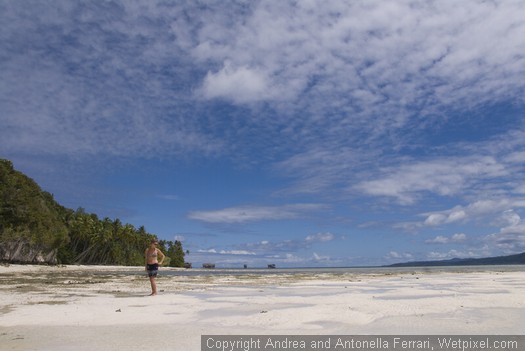
Around and above me, I can see limestone cliffs rising towards the sky, eroded in abstract shapes by thousands of years of tropical rainfall, draped in white roots, twisted vines, precariously balanced forest trees. Huge ferns and clumps of orchids hang everywhere, with a big swallowtail butterfly slowly flapping in the warm humid air here and there. Sitting under the canvas roof in the boat, a few meters away, Antonella smiles dreamily, points her camera at me and clicks away. I close my eyes again, absorbing the sun’s warmth, submerging my ears just enough to listen to the distant clicks and snaps of the coral reef extending a few feet below me. Yes, this is heaven for me. Welcome to the Passage. Welcome to Raja Ampat.
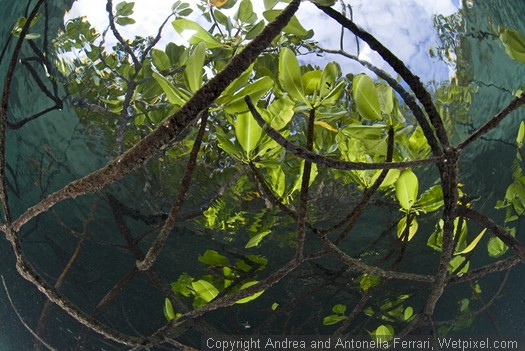
The Passage – a five-meter deep, river-like sea fjord, snaking inside the forest, the tree canopies often closing above it, strange purple sponges and gigantic orange sea fans almost reaching the surface, the sea and the sky above mirroring each other, mixing, inextricably blending into each other. A mystical place, rich in silent grottoes, underwater passages, submerged tunnels leading to still seawater pools hidden inside the forest, sun rays slanting down in the green darkness like light shining through a cathedral’s multicolored windows. The Passage – unique, and yet only one of the many wonderful dive sites found in Raja Ampat. Many, many others dot the area, close and not so close to peaceful Kri Island – Mike’s Point, the most beautiful of them all and one of the most scenic dive spots on Earth, a living multi-layered tapestry of pink and orange gorgonians; Sardines, an underwater promontory jutting out in the open sea where all the action is – raging currents, gigantic schools of fish, lurking wobbegongs waiting among the corals; Cape Kri, rated as the dive site with most fish species in the world, rivalling in technicolored spectacle Sipadan’s drop-off and Palau’s Blue Corner; Myos Kon, an underwater wonderland of lurking carpet sharks, pygmy seahorses and schooling yellow-lined snappers; Chicken Reef, a coral slope of a thousand untouched shapes and sizes, crowded with enormous schools of fish; Manta Point, a cleaning station where one can dive – if lucky – with up to twenty gigantic mantas, each up to three meters wide; Melissa’s Garden, by the island of Fam, a submerged psychedelic panorama of mushroom-shaped limestone islets draped in red gorgonians and bright purple soft corals.
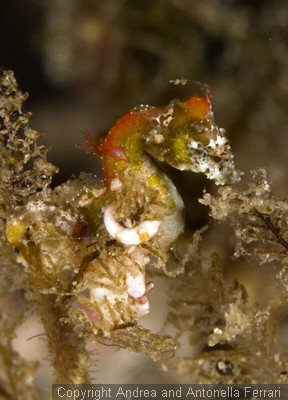
And fish - small fish, large fish - everywhere. Schools of fish, fish in the hundreds, in the thousands – jacks, surgeonfish, batfish, snappers, basslets, barracudas, emperors, giant bumphead parrotfish, spanish mackerels, rainbow runners – they’re all here. Even sharks, despite the widespread local fishing pressure, put in an appearance – large, camouflaged wobbegong carpet sharks are everywhere, and so are the “walking” Hemiscyllium coral catsharks, and swiftly swimming blacktips Carcharhinus melanopterus: even the grey reefs Carcharhinus amblyrhynchos, which had been absent two years ago, now make their presence felt, often buzzing divers on the reef top. In a world where shark sightings are going down in many locations in a matter of weeks, it is incredibly rewarding being able to report that here shark sightings are actually increasing. Might this mean the actual numbers of these beautiful, endangered predators are rising also in Raja Ampat? True, the practice of shark fishing goes on in the general area, but it is a fact that, at least in the proximity of Kri, blacktip and grey reef sharks (wobbegongs have never been an issue) seem to have found a sanctuary. The coral landscape does not show any signs of diver damage yet, and coral bleaching is almost unheard of in these waters. Indeed, on this, our second visit to these distant shores (see www.reefwonders.net for a trip report on the previous one), the spectacular diving and marine life of Raja Ampat seem to us even more extraordinary than in the past. Oh, and of course we have to add that most of this occurs at shallow depth – most diving takes place in the 5-20 meters range – with the majority of dive sites less than ten minutes away from Sorido’s or Kri’s wooden piers.
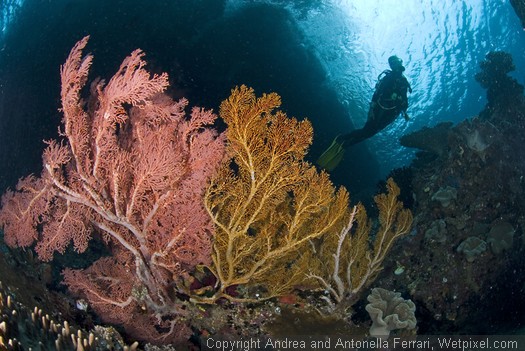
It’s quite obvious that the presence of Max Ammer’s tourist operations – traditional, long-standing Kri Eco Resort and the more luxurious and recently completed Sorido Bay Resort – is actually making a difference regarding conservation. Local fishing communities seem to be accepting Max’s strict views on conservation, and the income his business is providing to many Papuans is clearly convincing them protecting nature might actually be a good investment. In fact, the whole of Raja Ampat is being taken very seriously by conservationists worldwide and by the Indonesian government (to which West Papua is subject). Max recently wrote us announcing that “The Raja Ampat Regency Government in West Papua, Indonesia, has announced the launch of an annual tag system for visitors to their newly declared network of 7 Marine Protected Areas (MPAs). The annual plastic tag, modified from the successful Bunaken Marine Park tag, will be valid for 13 months from the 1st of each calendar year and will cost Rp500,000 (US$55) for international visitors and Rp250,000 (US$22) for Indonesian citizens. 70% of the funds will be managed by a multi-stakeholder team for conservation and community development programs. 30% of the fund will go to the Tourism Department for tourism development. The local government engaged the assistance of three major International NGOs - Conservation International, The Nature Conservancy and WWF - to help define the most valuable areas of Raja Ampat for protection”.
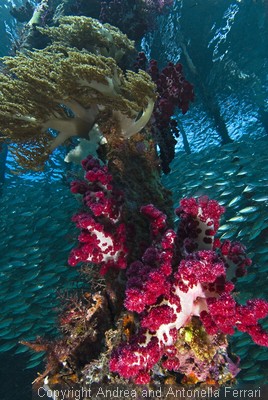
Raja Ampat is in the news – it’s a hot destination, the place you cannot miss. For those who do not know yet, this is a large area at the tip of the Bird’s Head peninsula at the western tip of the island of Papua New Guinea, which is itself equally split in the middle in two separate nations: independent Papua New Guinea proper in the East, and West Papua, a province of Indonesia once known as Irian Jaya, in the West. Raja Ampat itself comprises about 600 limestone islands and islets, the great majority of which are completely unpopulated and shrouded in virgin lowland forest, often with impenetrable, thick, blue-water mangrove belts surrounding them. The karst nature of the rock – covered by an thin layer of fertile soil originated by decaying organic matter – is responsible for the dry nature of the place, with seasonal rainfall disappearing immediately in the crevices of the rocky substrate. Fresh water is a premium, and at the same time its scarcity is a blessing in disguise – as it makes development of most islands impossible. Max Ammer’s Kri Eco Resort and Sorido Bay Resort on Kri island currently are the only land-based operations. A few liveaboards also show up in the area – but to all extents, this is a real frontier (the last one?) where daily ordinary maintenance is still very challenging, costs of living are still very high (everything has to be brought in by boat) and where professional underwater photographers and marine life scientists from all over the world are busy congregating. Drop in at beautiful, well-appointed (and quite expensive, bear that in mind) Sorido Bay Resort, and you might bump any time into people like David Doubilet, Gerry Allen, Stephen Wong & Takako Uno or the Tacketts – why, you might even meet the Ferraris there!
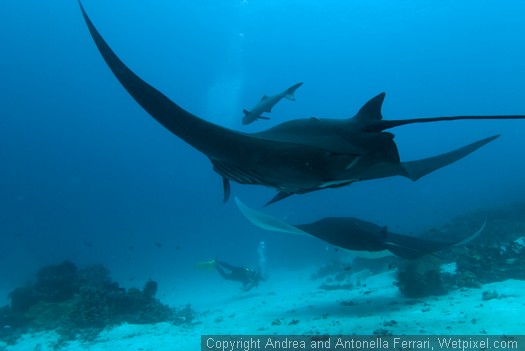
As a dive travel destination goes, Raja Ampat has few equals in the world – spectacular marine life (all sorts of stuff including carpet sharks, mantas, dolphins, rare flasher wrasses and four different species of pygmy seahorses – bargibanti, denise and two undescribed ones, possibly pontohi and colemani), incredibly scenic topside views, unique land wildlife (Sulphur-crested cockatoos, Eclectus parrots, Cassowaries, Cuscus – a cuddly, small, tree-dwelling marsupial - and two Birds of Paradise!), colorful, spirited and very friendly local people, and finally a good all-year round tropical climate. Occasionally, currents can be extremely strong (veteran dive guides Otto and Nikson know that in advance, however, and act accordingly) and visibility less than optimal, but these are – however bothersome to the underwater photographer – guarantees of a healthy, vital environment. No wonder all who can afford it are flocking there (well, flocking might be a big word – Raja Ampat currently gets less than 500 visitors a year), even if it’s a long, tortuous and occasionally unpredictable route: from Manado (Northern Sulawesi) on, you are advised to expect sudden flight cancellations and the like by the day. But it’s all part of the game – after all, Raja Ampat would not be the same without the unexpected, would it?
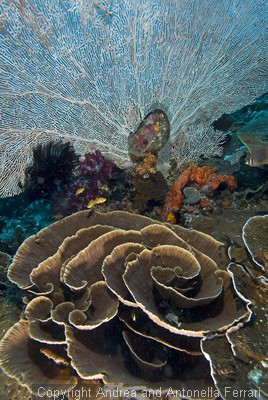
FACT FILE
Raja Ampat (meaning “The Four Kings”) refers to four large jungle-clad islands (Batanta, Waigeo, Misool and Salawati) which are part of a 600 islands and islets archipelago west of the coast of the Vogelskop or Bird’s Head Peninsula in West Papua, formerly known as Irian Jaya (this is the half of the island of Papua New Guinea politically belonging to Indonesia today). Culturally and historically rather similar to the Malukus (or Moluccas), the islands of Raja Ampat were ruled in the 15th Century by the Sultanate of Tidore, originating from Halmahera in the Malukus, and offer today unsurpassed topside scenic beauty, crystal-clear water and an unbelievable richness of marine life. The region can be easily reached with a short turboprop or jet flight by local airlines from Manado in Northern Sulawesi to Sorong, the harbour town from which transfer boats leave to Kri Eco Resort and Sorido Bay Resort.
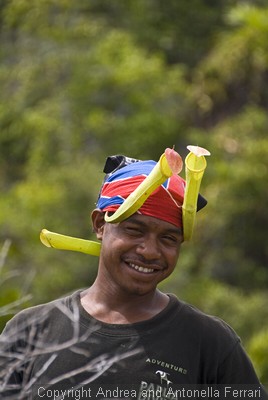
English is spoken at travel junctions and at the resorts. All necessary documents, flight reconfirmations and travel permits are obtained for visiting divers by the local staff of Papua Diving in Sorong and handed to you in Manado – remember however flight delays and cancellations are always possible due to a variety of reasons, so be prepared for the occasional hassle. When in Manado, stay overnight at Tasik Ria - besides their beautiful swimming pool they’ve now got a lovely new spa offering free jet-lag massages!
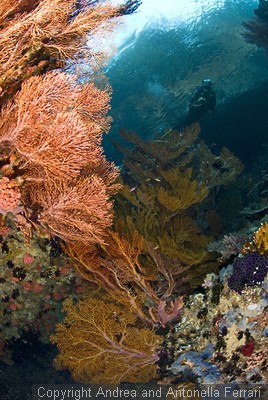
While camera and video facilities in Kri Eco Resort are rather basic, Sorido Bay Resort is exceptionally well-geared towards professional photographers and videographers, offering communal fresh-water rinsing tubs on the jetty, Apple computer stations in a dedicated air-conditioned camera room by the library and recharging power banks in every bungalow. Bali-built fiberglass dive boats are very comfortable, sturdy and fast, being equipped with oxygen and a very welcome canvas roof. Nitrox is available in both Sorido and Kri. Electricity is 220 V, being available 24 hrs a day. Cerebral malaria is present in the area – especially if you go for land excursions in the forest – so always remember to obtain recently updated, reliable medical information and do not underestimate the very real danger posed by this deadly mosquito-borne illness: when we go there we take our Malarone pills regularly and never have a problem. Be advised that given the owner’s religious beliefs – Max Ammer is a Seventh Day Adventist – Saturdays are strictly observed holiday days with no guided diving until 7.00 pm.
-Andrea and Antonella Ferrari